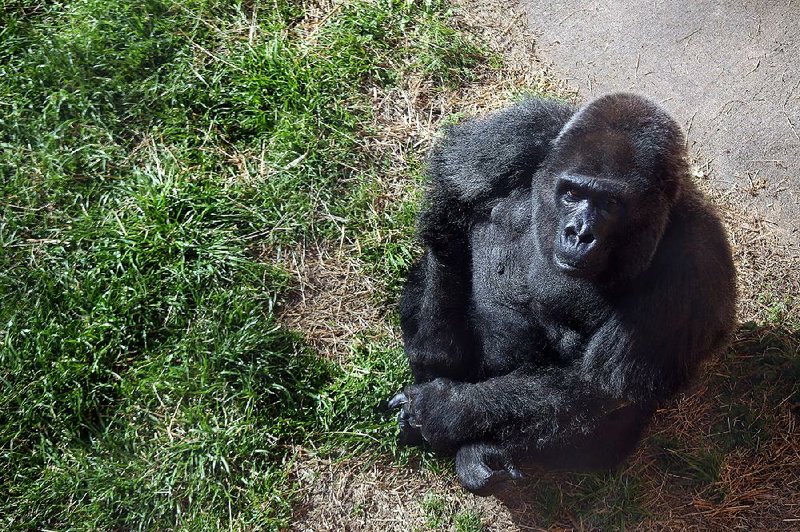The Little Rock Zoo will celebrate Trudy the gorilla's 61st birthday at an event at 11:45 a.m. Saturday. Read more about Trudy in this story that was first published in February 2017:
A short distance inside the Little Rock Zoo's gates, settled into her habitat in the Great Ape Display, the oldest known gorilla in the world sits basking in the occasional February sunlight with little fanfare.
Trudy, a 60-year-old Western lowland, became without dispute the oldest gorilla on record after Colo, a gorilla at the zoo in Columbus, Ohio, died in her sleep Jan. 17.
The national Association of Zoos and Aquariums confirmed its belief that Trudy now holds the title.
Colo was well-known in zoo circles. She was the first gorilla born in captivity. She turned 60 on Dec. 22, about a month before her death. Her birthday and her death were national news.
Trudy, on the other hand, was captured in the wild in Africa in 1957. As an infant, she was brought to the U.S.
Her exact birth date is unknown, but it's estimated she was born in June of 1956 -- which means she turned 60 last year, before Colo. But, the Little Rock Zoo never fought the Columbus Zoo for the title since records on Trudy's birth aren't exact. Trudy's age estimate comes from the Zoological Information Management System, zoo officials said.
Little Rock Zoo officials hope Trudy will now get more recognition.
"I would love for more people to know," said zookeeper Daphne Pfeiffer, who has worked in the Great Ape Display for the past 18 years. "Most members do know about Trudy. They'll visit and call her by name, and that's really cool. But I'd love for more visitors to know about it. She's not always outside, though."
While not a lot of people have heard of Trudy, one person knows her well: Little Rock zookeeper Ann Radamacher, who has helped care for Trudy and the zoo's other large primates for 27 years.
Radamacher said if Trudy could speak English, she'd have many stories to tell. With gorilla care changing along with new research and technology over the decades, Trudy has seen it all and lived in some atypical environments.
In the wild, gorillas typically live in groups of 20 or fewer, with one male silverback, multiple adult females and their offspring. That family dynamic wasn't known decades ago when gorilla conservation began in the U.S., and zoos often kept gorillas in male-female pairs.
Trudy first lived with a male named Rudy at the St. Louis Zoo, which purchased her from Trefflick's Bird and Animal Co. in 1958.
It was uncommon at the time to allow gorillas in captivity to raise their own young. She had one baby, who has since died, and she never conceived again.
In 1982, Trudy was transferred to the Buffalo Zoo in New York. She then moved to Little Rock in 1988 with a male named Ollie for the opening of the Great Ape Display, and the pair became the first gorillas ever exhibited in Arkansas.
Trudy now lives in a habitat nicknamed the "retirement exhibit" with Brutus, a 38-year-old male. There's plenty of brush and a pond. The pair previously raised two young bachelor silverbacks together -- not their own -- who have moved on to other zoos.
The Little Rock Zoo's other four gorillas, which range in age from 4 to 33, share an exhibit next-door that has a hammock, a walking bridge and more room to play.
"Trudy is very funny, because she's got very strong ideas about the regular zookeepers," Radamacher said. "She likes routine. If regular keepers are doing regular things, that's fine. But when you have got a new keeper in there, she does not like it. It's like she's saying, 'That is not your job. You don't belong here.' She's got this real sense of how things ought to be."
The Association of Zoos and Aquariums estimates that there are only 125,000 Western lowland gorillas still in existence in their African native habitat. Studies have shown that the species has declined by more than 60 percent over a 25-year period, according to the Red List of Threatened Species.
The primary threats to Western lowland gorillas are poaching, habitat loss and the Ebola virus.
In the wild, it's thought that a gorilla's average life span is 35 years. In captivity, with access to medicine and a regular supply of food, they live much longer.
Trudy has "typical aging issues" such as arthritis and poor eyesight, but no major health problems, Radamacher said.
"She's slower moving than she used to be. We kind of make special concessions for her. If she doesn't want to go outside on a day, even if it's a beautiful day, if she'd rather just hang out inside, that's fine. She can do whatever she wants," Radamacher said.
That makes it harder to deliver on marketing promises of seeing the "world's oldest gorilla" because zoo patrons might not get to see her when they visit. The Columbus Zoo has an indoor exhibit, so visitors there were almost guaranteed of seeing Colo on any given day.
If the sun's shining, Trudy is likely to venture outside, Radamacher said. She usually hangs out in a corner, keeping to herself. On a recent Wednesday, she cuddled up to some brush while Brutus took a nap.
Inside the gorilla exhibit's building, beyond the view of spectators, the animals have wire beds with nestlike bedding. Iron fences separate them from direct contact with zookeepers, although they can put their fingers through the fencing. And, they are trained to show their body parts during welfare checks.
In her old age, Trudy is slightly larger than the zoo's other female gorillas, weighing about 200 pounds. She's short and round. She also has a highly independent personality that Radamacher attributes to her years of living with male gorillas and never having the support of the female group that is typical in the wild.
"She stands up for herself. She's very opinionated. The silverbacks are big males, but if they push her too far, kind of bully her, oh my, no one wants to suffer the wrath of Trudy," Radamacher said. "She will scream and go after them and put them in a corner and tell them exactly what she thinks. She has a strong personality."
Pfeiffer said every day is different when working with the zoo's gorillas, learning their different personalities and seeing how they interact with the zookeepers that day.
The exhibit's youngest gorilla, 4-year-old Adelina, still thinks it's fun to play with the humans. The other two females are middle-aged and don't care too much about messing with the zookeepers, Pfeiffer said.
"It's like working with a bunch of kindergartners that are [up to] 300 pounds," she said.
SundayMonday on 02/12/2017

